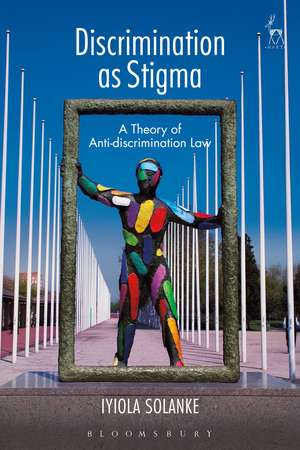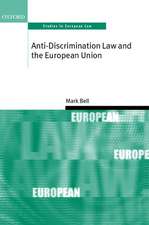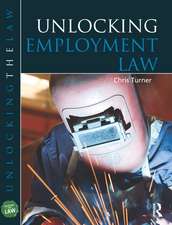Discrimination as Stigma: A Theory of Anti-discrimination Law
Autor Iyiola Solankeen Limba Engleză Paperback – 29 iun 2019
| Toate formatele și edițiile | Preț | Express |
|---|---|---|
| Paperback (1) | 270.67 lei 6-8 săpt. | |
| Bloomsbury Publishing – 29 iun 2019 | 270.67 lei 6-8 săpt. | |
| Hardback (1) | 568.40 lei 6-8 săpt. | |
| Bloomsbury Publishing – 25 ian 2017 | 568.40 lei 6-8 săpt. |
Preț: 270.67 lei
Preț vechi: 348.15 lei
-22% Nou
Puncte Express: 406
Preț estimativ în valută:
51.79€ • 54.08$ • 42.86£
51.79€ • 54.08$ • 42.86£
Carte tipărită la comandă
Livrare economică 04-18 aprilie
Preluare comenzi: 021 569.72.76
Specificații
ISBN-13: 9781509929825
ISBN-10: 1509929827
Pagini: 256
Dimensiuni: 156 x 234 x 13 mm
Greutate: 0.36 kg
Editura: Bloomsbury Publishing
Colecția Hart Publishing
Locul publicării:London, United Kingdom
ISBN-10: 1509929827
Pagini: 256
Dimensiuni: 156 x 234 x 13 mm
Greutate: 0.36 kg
Editura: Bloomsbury Publishing
Colecția Hart Publishing
Locul publicării:London, United Kingdom
Caracteristici
The author offers a practical method to reconstruct anti-discrimination law so that it incorporates both individual and social responsibility.
Notă biografică
Iyiola Solanke is Professor in EU Law and Social Justice at the School of Law, University of Leeds and an Associate Academic Fellow of the Inner Temple.
Cuprins
Introduction I. Construction of the Anti-stigma Principle II. Application of the Anti-stigma Principle 1. Stigma I. Defining Stigma II. Erwin Goffman and Stigma III. The Process of Stigmatisation IV. Developments in the Theory of Stigma V. Power VI. Conclusion 2. Legal Protection from Discrimination I. Introduction II. Equality and Inequality in Political Philosophy III. The Anti-discrimination Principle in International Law IV. Closed Lists V. Open Lists VI. Dignity, Immutability and the Anti-discrimination Principle VII. The Limits of Dignity VIII. The Idea of Immutability IX. Conclusion 3. Stigma and Litigation I. Goffman in Legal Scholarship II. Litigation in Europe III. Conclusion 4. The Anti-stigma Principle I. Linking Interpersonal and Structural Stigma II. Models of Stigma and Public Health III. The Discrimination VirusIV. Conclusion 5. Public Action to Combat Discrimination I. Tackling a Public Health Virus: The Ebola Outbreak of 2014 II. The Transmission of Stigma III. Positive Action and the Public Sector Equality Duty (PSED) IV. Public Action to Tackle the Virus of Discrimination V. Conclusion 6. Stigma, Synergy and IntersectionalityI. Understanding Intersectional Discrimination II. Categorisation in Anti-discrimination LawIII. Addressing Intersectional Discrimination IV. Applying Intersectional Discrimination V. Conclusion
Recenzii
Solanke's monograph offers a genuinely innovative theory of antidiscrimination law, embracing an interdisciplinary approach that remains all too rare in legal scholarship ... Focusing on the link between law and society can only be a good thing, particularly in such trying times. Solanke's monograph is highly recommended. It is a much-needed contribution to anti-discrimination scholarship.
...the author deserves praise for daring to tackle this subject in depth - something that has not been common amongst legal scholars until now ... In doing so, she has aided not only in highlighting the importance of the concept of stigma to questions regarding legal issues but also in encouraging others to follow suit.
It is rare that practitioners stand back and consider the theories, basic principles, the ideology and even the sociology underlying the legal concepts that are the day-to-day bread and butter of substantive law. When they do, as in the UNISON ET fees challenge, resulting in the Supreme Court's focus on the meaning of the concept of the rule of law and the role of access to the courts in maintaining the rule of law, the result may go far beyond expectations. Engaging with Solanke's work suggests a similar potential.
Solanke's project ... is doubtless a worthy one. And Solanke's emphasis on stigma as a key ingredient in a successful theory of discrimination law is a constructive contribution, pointing the way for future work in this rich field of inquiry.
Investigating the causal link between stigmatisation and discrimination is ... the agenda set by Solanke in her perspective-shifting and timely book Discrimination as Stigma: A Theory of Anti-Discrimination Law. By shifting the focus to stigmatisation, the book sheds a new light on discrimination theory... Solanke's book is both inspiring and thought-provoking. It can be highly recommended.
...the author deserves praise for daring to tackle this subject in depth - something that has not been common amongst legal scholars until now ... In doing so, she has aided not only in highlighting the importance of the concept of stigma to questions regarding legal issues but also in encouraging others to follow suit.
It is rare that practitioners stand back and consider the theories, basic principles, the ideology and even the sociology underlying the legal concepts that are the day-to-day bread and butter of substantive law. When they do, as in the UNISON ET fees challenge, resulting in the Supreme Court's focus on the meaning of the concept of the rule of law and the role of access to the courts in maintaining the rule of law, the result may go far beyond expectations. Engaging with Solanke's work suggests a similar potential.
Solanke's project ... is doubtless a worthy one. And Solanke's emphasis on stigma as a key ingredient in a successful theory of discrimination law is a constructive contribution, pointing the way for future work in this rich field of inquiry.
Investigating the causal link between stigmatisation and discrimination is ... the agenda set by Solanke in her perspective-shifting and timely book Discrimination as Stigma: A Theory of Anti-Discrimination Law. By shifting the focus to stigmatisation, the book sheds a new light on discrimination theory... Solanke's book is both inspiring and thought-provoking. It can be highly recommended.










